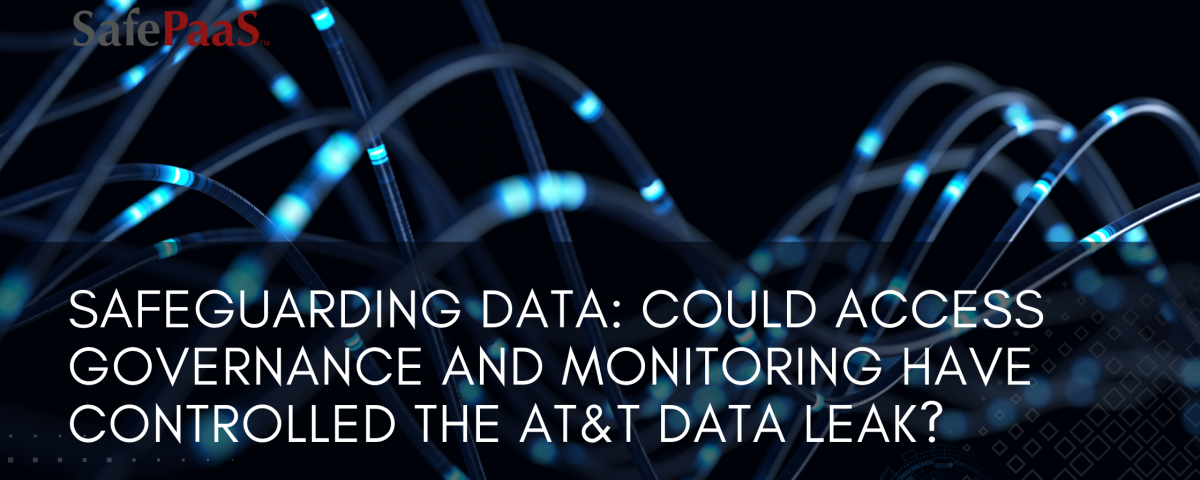Safeguard Data with Access Governance and Monitoring


Safeguarding Data: Could Access Governance and Monitoring Have Controlled the AT&T Data Leak?
In today's interconnected digital world, safeguarding sensitive customer data is critical. However, recent reports reveal the vulnerability of data, with the news that information from 73 million AT&T accounts has been leaked on the dark web. This breach poses a threat to individual privacy and highlights the importance of robust access controls and vigilant monitoring in preventing similar incidents.
The Scope of the Breach
The data set, released about two weeks ago on the dark web, includes personal information such as Social Security numbers, phone numbers, email addresses, full names, dates of birth, and mailing addresses. As a precaution, AT&T reset the passcodes of 7.6 million current customers.
The Role of Access Controls and Monitoring
Access governance plays a crucial role in mitigating data breaches' impact beyond the previously discussed measures. Here are additional ways access governance could have helped prevent or reduce the impact of the AT&T data leak:
Policy-Based Access Control (PBAC): Implementing PBAC allows organizations to assign permissions to users based on their roles within the company. This ensures that individuals can only access the data and systems necessary for their job responsibilities. By enforcing least privilege access, organizations can limit the potential damage caused by a breach, as attackers would have access to a smaller subset of data.
Granular Access Controls: Organizations can reduce the likelihood of unauthorized access by limiting access to sensitive data to authorized individuals only and implementing strong authentication mechanisms.
Regular Access Reviews: Conducting regular access reviews and audits helps ensure that access permissions align with current business needs. By regularly reviewing and updating user access privileges, organizations can identify and revoke unnecessary access, reducing the attack surface and minimizing the risk of unauthorized data exposure.
Automated Provisioning and Deprovisioning: Implementing automated provisioning and deprovisioning processes streamlines user access management throughout the employee lifecycle. When employees join or leave the organization, automated processes can grant or revoke access to systems and data promptly, reducing the likelihood of orphaned accounts or unauthorized access due to outdated permissions.
Multi-Factor Authentication (MFA): Enforcing MFA adds an extra layer of security by requiring users to provide multiple verification forms before accessing sensitive systems or data. Even if an attacker obtains login credentials through a data breach, they would still need additional authentication factors to gain access, significantly reducing the likelihood of unauthorized entry.
Database Monitoring: Continuously monitor database activities in real-time to identify and respond to suspicious or unauthorized access attempts.
By incorporating these additional access governance measures into their cybersecurity strategy, organizations can further enhance their ability to prevent, detect, and respond to data breaches, ultimately minimizing the impact on both the organization and its stakeholders.
Addressing the Aftermath
AT&T has initiated investigations with the help of cybersecurity experts, both internal and external, to determine the source of the leaked data. While the source remains unknown, the company is taking proactive steps to notify affected customers and provide credit monitoring services where applicable.
Lessons Learned and Future Preparedness
The AT&T data leak is a reminder of the pervasive threat posed by cyberattacks and the need to prioritize cybersecurity measures. By investing in robust access governance and continuous monitoring, companies can strengthen their defenses against data breaches and reduce the potential impact on their customers and stakeholders.
As data breaches continue to occur, it's clear that no organization is immune to security threats. However, by adopting a proactive perspective towards security and implementing robust access governance and monitoring mechanisms, companies can significantly reduce their risk exposure and safeguard the integrity of sensitive data. Vigilance and preparedness are essential in the ongoing battle to protect against data breaches and maintain the trust of our customers and stakeholders.
Recommended Resources

Getting Access Certification Right
Access certification is a critical process for organizations concerned with accountability, risk management, and regulatory compliance. Automating the access certification process increases access accuracy and effectiveness while formalizing the process for audit purposes.

Locking down Access Controls across the IT ecosystem
Many organizations rely on manual controls for key applications in their audits, exporting reports and sending them for laborious manual approvals via email. Trusting error-prone manual controls to protect you and your critical systems and data from threats is a gamble.

Access Governance vs Access Management
While these terms may seem interchangeable, they represent distinct yet interrelated aspects of your organization's security and data management strategy. This blog will explore the differences between Access Governance and Access Management and why both are crucial for your organization.

